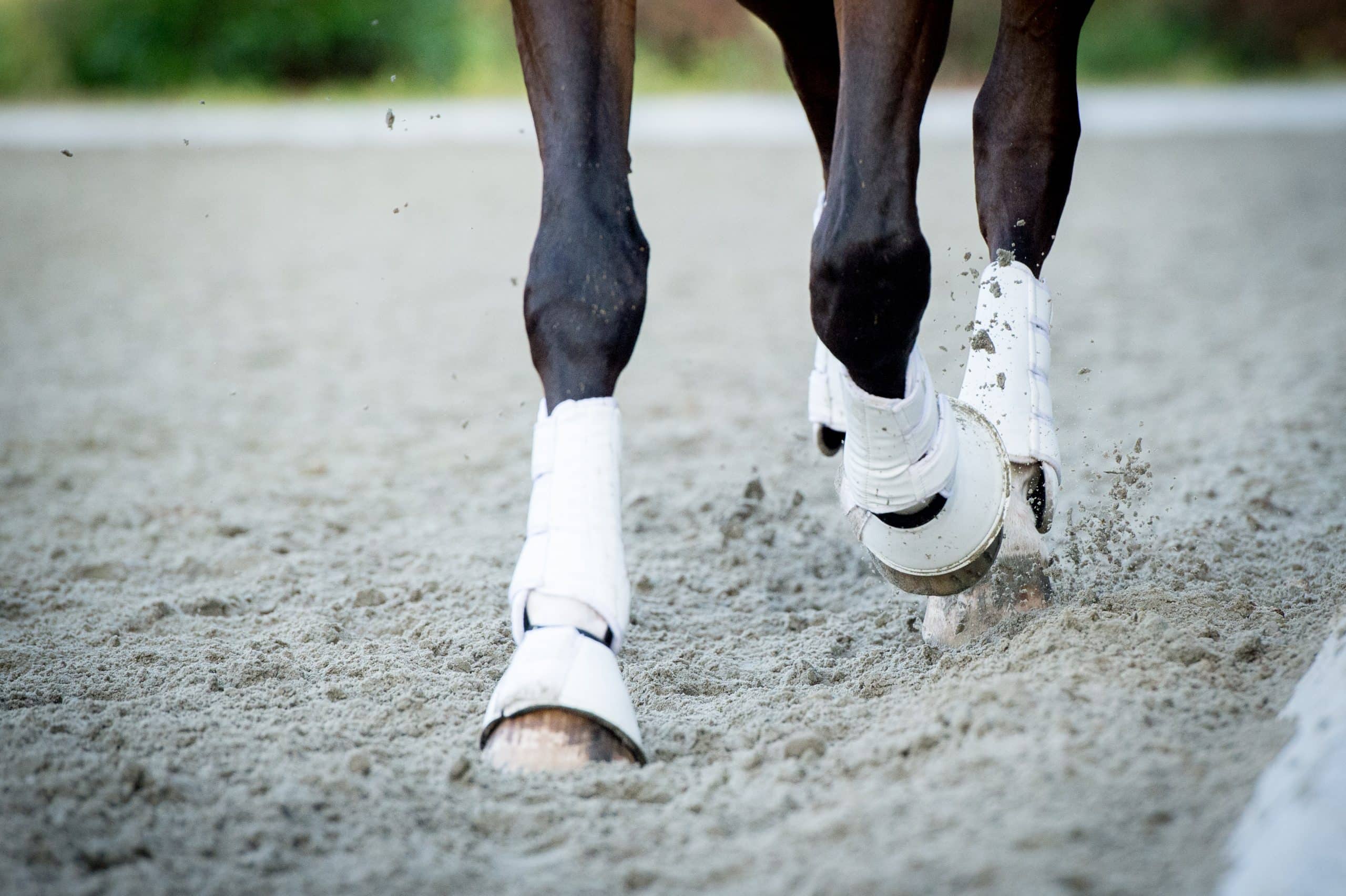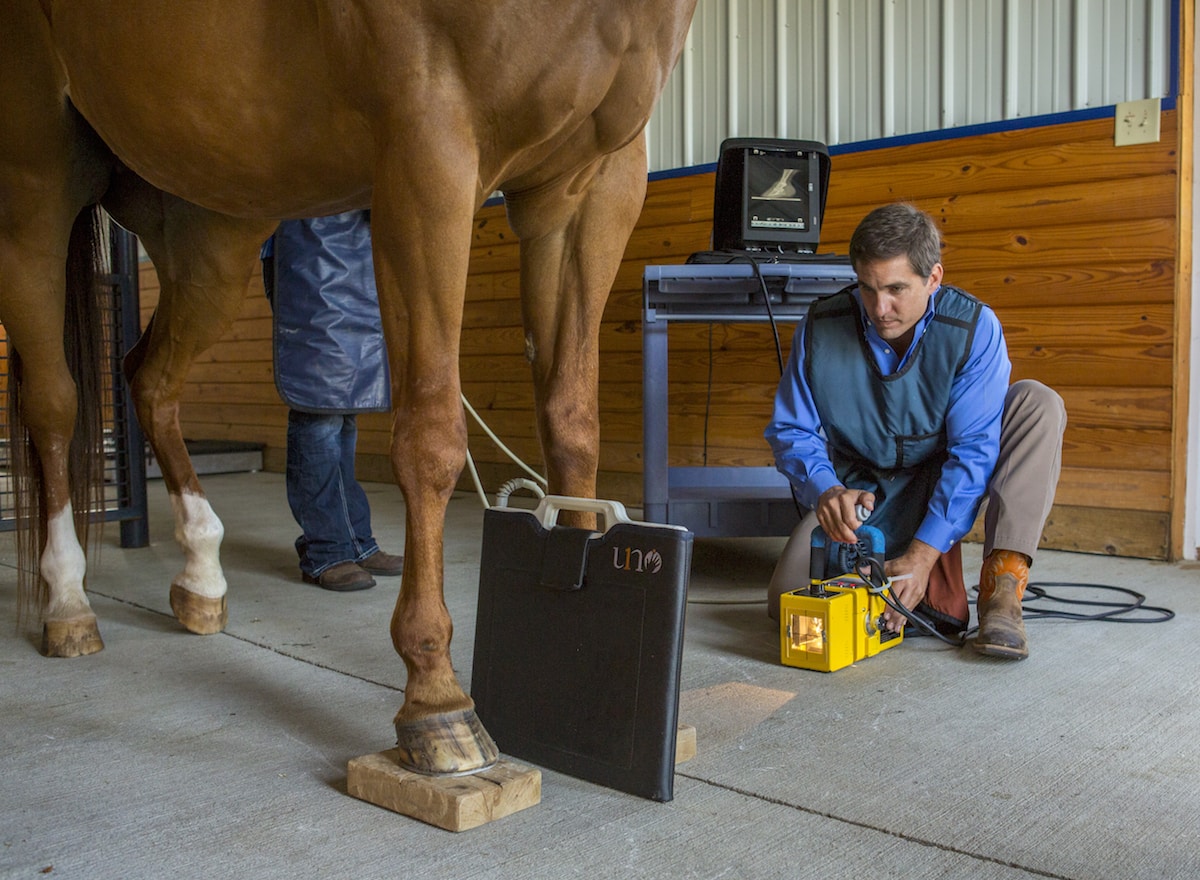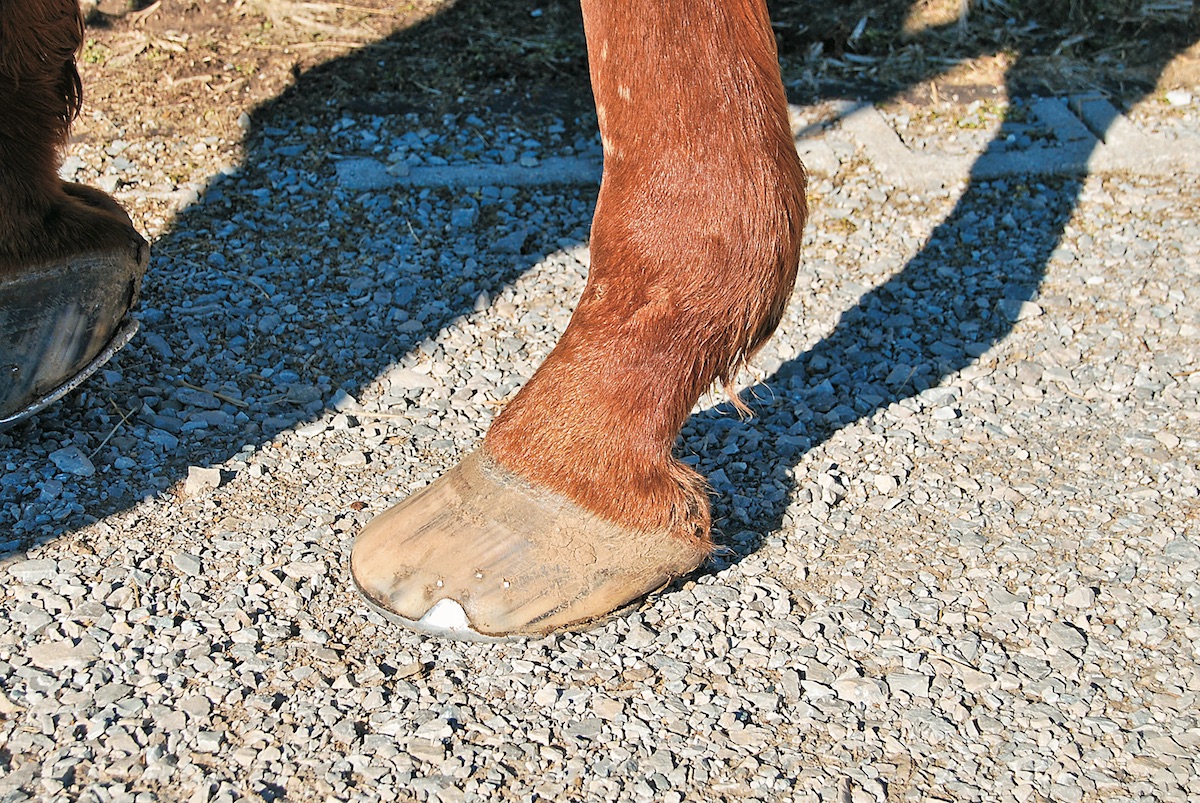Management approaches can help get your OTTB started on the right foot.

Closeup of the hooves from a horse while in trot on an outside track
Thoroughbreds are known for their many wonderful qualities: Endurance, athleticism, sensitivity, loyalty, trainability and beauty, just to name a few. But their feet? Maybe not so much. So, do we assume all Thoroughbreds have hoof problems?
Hoof care and horse health experts say no. “Simply generalizing that Thoroughbreds don’t have good feet probably isn’t fair or accurate,” says Patrick Reilly, CJF, head farrier at the University of Pennsylvania School of Veterinary Medicine’s New Bolton Center, in Kennett Square.
There are management approaches, however, you can take to combat issues that tend to pop up in Thoroughbreds and ex-racehorses in general, such as thin soles, long-toe/low heels, and weak hoof walls, says Raul Bras, DVM, CJF, a podiatrist with Rood & Riddle Equine Hospital, in Lexington, Kentucky. We talked to Reilly, Bras and other horse health professionals to help you get your OTTB started on the right foot.
Get an Expert Opinion
When considering an OTTB (or any horse, for that matter) as a second-career prospect, Bras recommends having both your veterinarian and farrier evaluate the horse’s feet. That way, they can work together to identify issues and create a treatment and management plan.
When looking at the horse, “evaluate the horse as an individual, not a breed,” Bras stresses.
Your veterinarian should perform a thorough prepurchase exam (PPE) to assess the horse’s overall health. In addition to taking vital signs and evaluating overall soundness and condition, the PPE should include a visual inspection of the horse’s hooves, looking at:
■ Balance and angles Do the front hooves match? How about the hind feet? Are the hoof angles appropriate when compared contextually to the pastern angle (the hoof ideally follows the pastern angle)?
■ Frog quality Is the frog symmetrical, well-developed, spongy and centered in the foot?
■ Hoof wall quality Is the hoof wall thick and hard, or thin, “shelly” and prone to breaking? Is it smooth, or does it show signs of deformation, which could indicate a history of laminitis?
■ Heel alignment Is each side of the heel balanced, similarly placed and set optimally under the back of the hoof, rather than running forward?
■ Bar structure Are the bars (the inward folds of the hoof wall, located on either side of the frog) deep and well-formed?
■ Coronet band Is it smooth, with hair growing flat along the skin and hoof, rather than puckering or sticking up? Are there any signs of damage left over from cracks that reach the coronet band?
■ Sole Are there signs of bruising, such as dark or red spots, or is the horse tender in response to hoof testers?
Beyond this visual inspection, taking radiographs will allow your veterinarian to evaluate the foot’s internal structures, such as the coffin and navicular bones, and record the horse’s sole depth. He or she will search for signs of bone or joint disease and possible past trauma. If you decide this Thoroughbred is the right horse for you, then referring to radiographs can also help your farrier best trim and shoe your horse to meet the animal’s individual needs.
The point, Bras says, is to evaluate if the horse is appropriate for his next career, and if he is, create a baseline for the horse, as well as a treatment or management plan to address any possible foot issues and rehab needs.

Prepurchase Exam; X Ray; Radiograph; Forelimb; Hoof;
Park Equine Hospital in Lexigton, Kentucky on July 15, 2014
Photo by: Kevin Thompson
Transition From the Track Carefully
Racehorses live regimented routines. They’re typically housed in bedded stalls, walked on manicured paths and exercised on carefully engineered footing. It’s unlikely for one to navigate rocky paths on a trail or gallop cross-country over varied terrain.
“The environment at the racetrack, from a hoof perspective, can be very different from a new career,” Reilly says, pointing out that horses need time to adjust to new living situations, footing and training regimens, as well as from aluminum racing plates to bare feet or steel shoes.
And, as is the case with any performance horse, constant moisture from regular post-workout baths, combined with dry bedding, can create a wet-dry cycle that weakens the hoof wall and softens the sole, Reilly adds.
Todd Beckwith, a farrier in Bend, Oregon, with 40 years of experience, offers additional insight. Many of the OTTBs he shoes at dressage and jumper barns are project horses that went from track to pasture and maybe to auction before landing in the capable hands of ambitious young trainers. During post-racing downtime between careers, regular hoof care sometimes falls to the wayside, he notes. “The horse’s foot problems aren’t the horse’s fault,” he says. “It takes time to bring those feet back. But, when shod right, a Thoroughbred’s feet are some of the most symmetrical feet out there.”
A horse’s hoof capsule can take from nine months to a year to regenerate completely, Reilly says, which means transitioning feet from the track or rehabbing them after extended turnout requires patience. Bras adds that you can usually expect positive changes to occur within three or four shoe cycles (15 to 20 weeks). Some horses might take longer.
Make Big Changes Slowly
Farriers and veterinarians recommend making hoof changes slowly over several shoeing cycles, allowing the hoof and the leg’s soft tissue structures, such as tendon and ligaments, to adapt. This is especially true of the OTTB, who is likely moving from lightweight aluminum racing plates to heavier steel shoes.
Racing-shod horses often, but not always, have long toes, Bras says, attributing the practice to a long-held (and inaccurate) belief that longer feet equal longer strides. As the horse transitions to his new job, Bras recommends pulling those toes back slowly to avoid tendon and ligament injuries.
Beckwith prefers a five-week foot-care cycle for any horse needing adjustment. That way he can make changes incrementally but in rapid succession.
If transitioning your Thoroughbred to bare feet, Bras recommends only pulling the hind shoes at first, rather than all four, and monitoring how the horse does with this change before pulling front shoes. And that leads us to …
Give the Foot Support
Bras, who lives and works in the heart of Thoroughbred country, says it’s not uncommon to find weak hoof walls and thin soles in Thoroughbreds, especially right off the track. The breed might have a genetic propensity for thin soles, and that, combined with rigorous workouts six days a week, can wear the sole even thinner.
For that reason, Bras warns against pulling a Thoroughbred’s shoes immediately (remember Tip No. 3). “Before you jump into barefoot, you want to ask, ‘What are the needs of the horse?’ ” he says.
If during the PPE your veterinarian identified certain hoof pathologies, such as long-toe/low-heel syndrome, thin soles, thin walls or navicular changes (see sidebar on page 79 for more information on each), your farrier might choose to support the hoof with a bar shoe, hoof fillers or pads, Beckwith says. Offering the horse support with a therapeutic shoe, he adds, can prevent future hoof wall degradation, improve circulation and prevent soreness.
Take-Home Message
Many Thoroughbreds have good feet, while others benefit from therapeutic shoeing and management changes to improve hoof quality. Whether you’re considering a recently retired racehorse as a prospect or already have one under your care, treat each Thoroughbred as an individual, and work with your veterinarian and farrier to evaluate and manage his hoof health. Foot problems can occur post-racing as the horse lets down, so ensure he’s getting the nutrition he needs to support hoof health, monitor for signs of soreness or hoof disease and make shoeing and trimming changes gradually. With care and attention, the Thoroughbred’s feet can carry him soundly into his new career.
Common Foot Issues That Might Affect OTTBs
Anecdotally, Thoroughbreds are known for having long toes and low, underrun heels. Courtesy The Horse Staff
Well, we all can’t be perfect, and that goes for our Thoroughbreds’ feet, too. The following are a few hoof problems you might encounter:
Low heels/long toes Underrun heels occur when the heels grow in at a lower angle than the toe. As a result, the hoof angle gets lower as the hoof grows, and the horse ends up with a long-toe/low-heel conformation. While horse people might try to pin this on race training, Patrick Reilly, CJF, head farrier at the University of Pennsylvania School of Veterinary Medicine’s New Bolton Center, in Kennett Square, says a direct correlation is unlikely, because underrun heels are common in all breeds, not just Thoroughbreds.
“There are a couple of studies observing underrun heels to occur in about 50% of all front feet,” Reilly says. “(We have) several theories as to why horses develop underrun heels, but there’s no clear understanding for why they develop, and there is no evidence, to my knowledge, supporting a higher incidence of underrun heels in racehorses.”
Management includes therapeutic shoeing with a focus on shortening the toe, supporting the heel and encouraging heel growth.
Shallow sole depth The sole stands between the ground and the soft structures within the hoof. A horse with a flat foot is more likely to make contact with rocks and bruise his foot, and a thin sole (less than 10 mm thick, says Raul Bras, DVM, CJF, a podiatrist with Rood & Riddle Equine Hospital, in Lexington, Kentucky) offers less-than-ideal protection. Bruising can lead to more problems, such as hoof abscesses (localized infections), seromas (fluid buildups) and even sepsis (infection in the bloodstream).
Preventing sole wear with protective shoeing, keeping the horse in a hoof-friendly environment (i.e., sanitary with minimal mud) and encouraging circulation with exercise and proper shoeing can help improve solar depth.
Navicular Research shows that navicular syndrome or — as veterinarians currently call it — podotrochleitis or podotrochlosis, is most common in Quarter Horses, Warmbloods and Thoroughbreds. It’s mostly found in geldings, although researchers don’t have a clear understanding of why, and it occurs mostly in front feet and very rarely in the hind. This foot syndrome involves the small canoe-shaped navicular bone, as well as its supporting soft-tissue structures. A complex disease with no cure, veterinarians strive to manage navicular with therapeutic shoeing, non-steroidal anti-inflammatories and bisphosphonate drugs.
Laminitis Laminitis is a systemic disease that results in the breakdown of the hoof’s laminae, which are the soft, accordionlike tissues that hold the coffin bone in place.
Laminitis usually occurs in the front feet, has several causes (from endocrine disorders and overeating to trauma and foaling difficulties) and is often tied to stress. For the Thoroughbred recently off the track, that stress could stem from training, transport, diet changes or injury recovery, Bras says, adding he often sees laminitis in Thoroughbred broodmares, likely due to breeding and pregnancy stress and access to rich pastures.
Signs that a horse has suffered past laminitic episodes include hoof wall separation at the sole/wall junction, coffin bone rotation and deformed hoof capsules. Acute clinical signs include a throbbing digital pulse and the horse rocking back to remove weight from his painful front feet. Managing a laminitic horse requires a personalized, multimodal approach that responds to the disease’s root cause.


